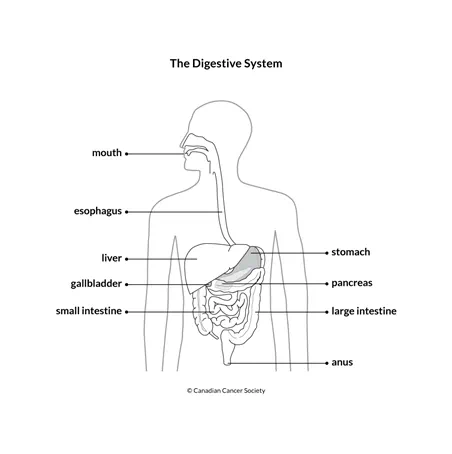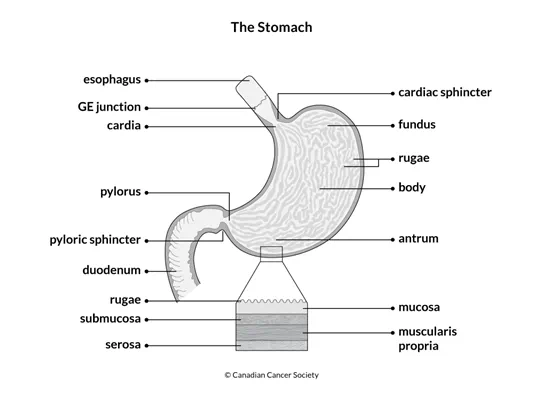The stomach
The stomach is a muscular, J-shaped organ in the upper part of the abdomen. It is a
part of the
The top of the stomach is connected to the

Areas of the stomach
The stomach is divided into 5 areas:
- The cardia is the first part of the stomach, which is connected to the esophagus. It contains the cardiac sphincter, which is a thin ring of muscle that helps to prevent stomach contents from going back up into the esophagus.
- The fundus is the top, rounded area that lies to the left of the cardia.
- The body is the largest and main part of the stomach. This is where food is mixed and starts to break down.
- The antrum is the lower part of the stomach. It holds the broken-down food until it is ready to move into the small intestine.
- The pylorus is the part of the stomach that connects to the small intestine. It includes the pyloric sphincter, which is a thick ring of muscle that acts as a valve to control the emptying of stomach contents (chyme) into the duodenum (first part of the small intestine). The pyloric sphincter also prevents the contents of the duodenum from going back into the stomach.

Layers of the stomach wall
The stomach is made up of several layers of tissue:
-
The
mucosa (mucous membrane) is the inner lining of the stomach. It is made up of
glands and specialized cells that makemucus , hydrochloric acid andenzymes . The mucosa has ridges (rugae) when the stomach is empty. The ridges flatten out as the stomach fills with food. - The submucosa is a layer of connective tissue that surrounds the mucosa. It contains larger blood and lymph vessels, nerve cells and fibres.
- The muscularis propria (muscularis externa) is the next layer that covers the submucosa. It is the main muscle of the stomach and is made up of 2 layers of muscle.
-
The
serosa
is the fibrous membrane that covers the outside of the stomach. The serosa
of the stomach is also called the
visceral peritoneum .
How the stomach works
When you see, smell or think of food, your central nervous system (CNS) sends a
message to your stomach to make acids, enzymes and mucus for digestion (called
gastric juice). Endocrine cells in the stomach release the
After food and liquids are swallowed, they travel through the esophagus to the stomach. The muscles of the stomach wall tighten (contract) and relax (expand), which mixes the food with the acids and enzymes. Mucus helps protect the lining of the stomach from the acids.
Food and liquids are broken down into a thick, acidic, soupy mixture called chyme. Once chyme is formed, the pyloric sphincter relaxes. Then the stomach muscles tighten and relax to help move the chyme into the duodenum where digestion continues and many nutrients are absorbed (taken up).
The stomach does not have a big role in absorption of food. It absorbs only water, alcohol and some drugs.
Your trusted source for accurate cancer information
With support from readers like you, we can continue to provide the highest quality cancer information for over 100 types of cancer.
We’re here to ensure easy access to accurate cancer information for you and the millions of people who visit this website every year. But we can’t do it alone.
Every donation helps fund reliable cancer information, compassionate support services and the most promising research. Please give today because every contribution counts. Thank you.
